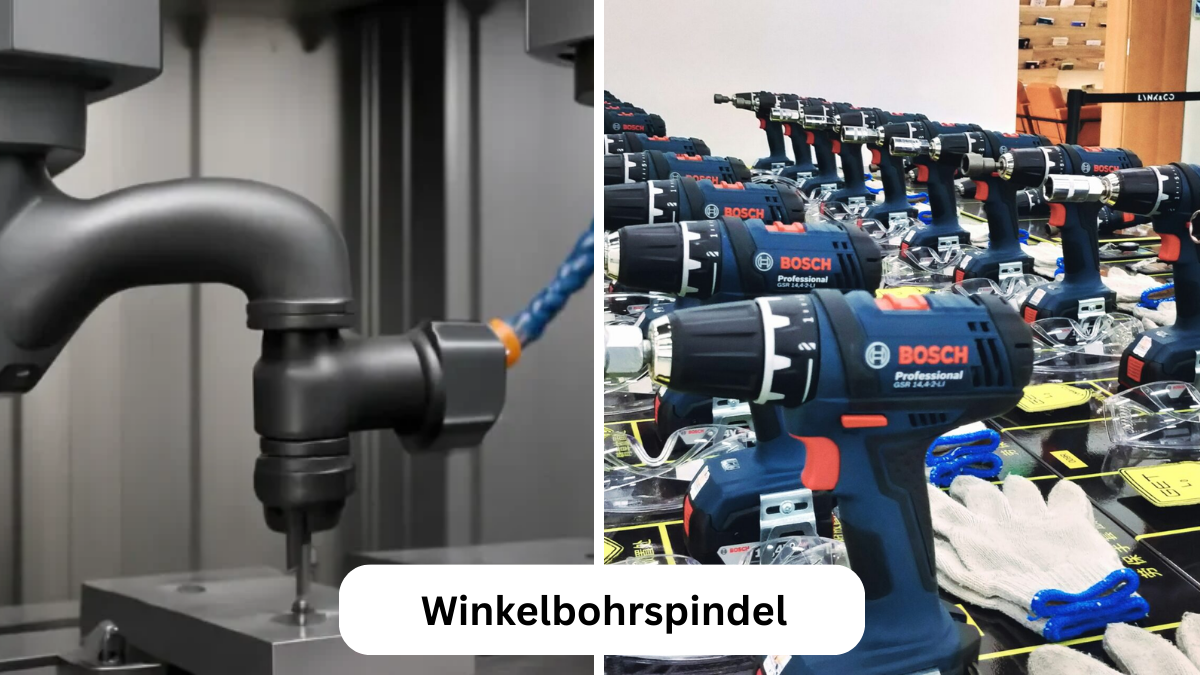Introduction to Winkelbohrspindel
In the field of machining and industrial manufacturing, specialized tools play a critical role in achieving precision, efficiency, and versatility. One such tool that has captured attention in recent years is the Winkelbohrspindel. The term refers to an angle drilling spindle, a device engineered to perform drilling operations at specific angles where traditional drilling machines or spindles may fall short. With industries demanding increasingly complex components and higher levels of accuracy, the Winkelbohrspindel has become an indispensable tool in both small-scale workshops and large industrial facilities.
Exploring the concept of the Winkelbohrspindel allows us to understand not only its mechanical design but also its influence on modern engineering practices. From aerospace to automotive and even precision medical manufacturing, this tool has expanded the boundaries of what can be achieved in machining.
The Concept of Winkelbohrspindel
A Winkelbohrspindel is designed to enable drilling and machining at non-standard angles. Traditional drilling systems operate along fixed vertical or horizontal axes, which limits their ability to tackle components requiring angled bores. The Winkelbohrspindel solves this problem by introducing adjustable spindles that allow drilling heads to rotate and cut at precise angles.
This adaptability makes it possible to create components with complex geometries without compromising accuracy. The tool is usually attached to milling machines, CNC systems, or specialized drilling equipment, where it extends the capabilities of the machine to new levels. The Winkelbohrspindel is not just about drilling holes; it is about achieving flexibility in production processes and responding to modern demands for intricate design and high tolerances.
Evolution of Drilling Technology
To truly appreciate the importance of the Winkelbohrspindel, it is necessary to look at the evolution of drilling. Early manufacturing processes relied on manual drills and simple spindles that offered limited precision. As industries grew more complex, machines had to adapt to higher performance standards. The introduction of machine tools in the industrial revolution marked a turning point, yet even then, standard drills could not handle angled operations effectively.
The development of angle spindles represented a breakthrough. By integrating them into machine tools, manufacturers gained the ability to cut and drill with unmatched versatility. Today, the Winkelbohrspindel represents the culmination of decades of engineering innovation, offering a refined and reliable solution to a longstanding manufacturing challenge.
Applications Across Industries
The Winkelbohrspindel finds applications in a broad range of industries. In the aerospace sector, aircraft components often require angled holes for fasteners, hydraulic systems, and other critical elements. The precision and strength of the Winkelbohrspindel make it a valuable tool for such high-stakes tasks.
In the automotive industry, engine blocks, gearboxes, and transmission systems often require drilling at unique angles. The Winkelbohrspindel provides the capability to machine these parts without having to reposition the entire workpiece, saving time and improving accuracy.
Medical technology is another field that benefits from this tool. Surgical instruments and implants demand exceptionally precise angles and shapes, where errors are not acceptable. The Winkelbohrspindel helps manufacturers meet these stringent requirements.
Additionally, general mechanical engineering and toolmaking industries use the Winkelbohrspindel to increase production flexibility, allowing workshops to take on complex projects that would otherwise be impossible or extremely costly.
Technical Advantages of Winkelbohrspindel
The Winkelbohrspindel provides several technical advantages that explain its growing popularity. One of its primary strengths is precision. By maintaining exact angular positions, it ensures that every drilled hole or machined feature meets tolerance specifications.
Another major advantage is efficiency. Without an angle spindle, operators might have to reposition workpieces multiple times, which increases production time and the risk of errors. The Winkelbohrspindel eliminates these inefficiencies by allowing the machine to adapt to the required angle directly.
Durability is also a key benefit. Engineered from high-quality materials, these spindles are capable of withstanding the stresses of industrial use while maintaining consistent performance. Many Winkelbohrspindeln are also designed with lubrication and cooling systems to ensure longevity during continuous operations.
Integration with CNC Technology
One of the reasons the Winkelbohrspindel has become more important in recent years is its integration with computer numerical control (CNC) systems. CNC machining has revolutionized manufacturing by enabling automated, precise, and repeatable processes. By attaching Winkelbohrspindeln to CNC machines, operators unlock new possibilities in part design and production.
For example, complex aerospace components can now be programmed into CNC machines with angled drilling operations handled seamlessly by the spindle. This reduces human intervention, increases accuracy, and significantly cuts down on production cycles. In many modern factories, the combination of CNC systems with Winkelbohrspindeln represents the pinnacle of machining technology.
Challenges in Winkelbohrspindel Usage
Despite its many advantages, the Winkelbohrspindel is not without challenges. One of the main concerns is cost. High-quality angle spindles are expensive to manufacture, which can make them a significant investment for small workshops. Additionally, their integration with machines may require specific technical knowledge and training.
Another challenge is maintenance. Because of the precise mechanics involved, regular upkeep is necessary to ensure that the spindle continues performing accurately. This includes lubrication, calibration, and occasionally replacing parts subject to wear and tear.
Finally, while the Winkelbohrspindel allows for remarkable flexibility, it still requires careful planning and programming in CNC environments to ensure that the toolpaths are efficient and collision-free.
The Future of Winkelbohrspindel Technology
The future of the Winkelbohrspindel appears promising, with ongoing advancements in materials, design, and digital integration. For instance, manufacturers are increasingly developing lightweight yet durable spindles that can handle higher rotational speeds without sacrificing accuracy. Integration with smart manufacturing systems and Industry 4.0 is also likely to expand the capabilities of the Winkelbohrspindel.
In the near future, it is expected that spindles will feature built-in sensors to monitor performance in real time, ensuring predictive maintenance and reducing downtime. Furthermore, as additive manufacturing and hybrid technologies continue to evolve, the Winkelbohrspindel may play a role in combining drilling with 3D-printed structures, creating new opportunities for design innovation.
Environmental Considerations
Modern manufacturing places emphasis not only on precision but also on sustainability. The Winkelbohrspindel contributes to eco-friendly practices by minimizing waste and reducing the need for multiple setups. By improving efficiency and reducing errors, manufacturers save on raw materials and energy consumption.
Additionally, advanced cooling systems integrated into Winkelbohrspindeln use less coolant and recycle it effectively, further supporting environmental goals. This focus on sustainability makes the spindle not only a technical asset but also a responsible choice for future-oriented industries.
Conclusion
The Winkelbohrspindel stands as a symbol of precision, flexibility, and innovation in modern machining. From its origins as a solution to angled drilling challenges, it has evolved into a sophisticated tool integrated with CNC systems and widely used across industries. Its role in aerospace, automotive, medical technology, and general engineering underscores its importance in shaping the future of manufacturing.
While challenges such as cost and maintenance exist, the advantages of the Winkelbohrspindel far outweigh these limitations. Its ability to improve efficiency, ensure accuracy, and adapt to evolving industrial demands makes it an indispensable tool for workshops and factories alike. Looking ahead, the continued development of this technology promises even greater contributions to engineering and sustainability.
FAQs
What is a Winkelbohrspindel?
A Winkelbohrspindel is an angle drilling spindle used in machining to perform drilling and cutting operations at specific angles that standard drills cannot achieve.
Which industries use Winkelbohrspindeln the most?
They are commonly used in aerospace, automotive, medical device manufacturing, and general engineering due to their precision and flexibility.
How does a Winkelbohrspindel improve efficiency?
By eliminating the need to reposition workpieces for angled drilling, it saves time, reduces errors, and enhances production efficiency.
Are Winkelbohrspindeln compatible with CNC machines?
Yes, they integrate seamlessly with CNC systems, allowing for automated and precise angled drilling operations in complex components.
What is the future of Winkelbohrspindel technology?
Future developments include lighter, stronger designs, integration with smart manufacturing, built-in sensors for monitoring, and improved sustainability features.




